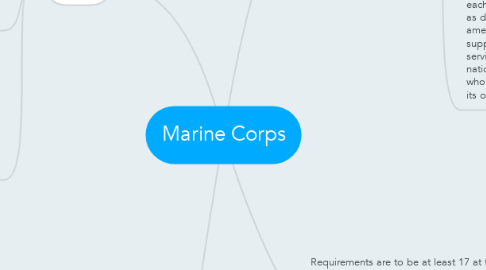Marine Corps
저자: darren franzman

1. Infantry
1.1. Requirements are to be at least 17 at time of enlistment, has not reached 29th birthday at enlistment. Proof of legal residency, physical examination, High school diploma also recruit training at MCRD Parris Island & school of infantry (SOI) or Marine combat training (MCT) & Military occupational speciality school (MOS).
1.2. Infantry Training Battalion (ITB) is a 59-day course. The mission is to train, mentor and evaluate Infantry Marines in specific entry-level tasks under the leadership of Combat Instructors. Marines are instructed in marksmanship, patrolling, grenade usage, identifying and countering improvised explosive devices and land navigation, among other various infantry skills. In doing so, the Infantry Training Battalion provides the Corps with Marines who are fully prepared for service in the operating forces.
1.3. The primary role of the School of Infantry is to ensure, first and foremost, that "every Marine a rifleman." All Marine Corps assets exists to support the rifleman on the ground, and every Marine is prepared to do whatever it takes to ensure the safety of the Marines to their left and right. Regardless of MOS, the ITB mission ensures every Marine has the capability to fulfill his or her duties while operating in a combat environment.
2. history
2.1. "On November 10, 1775, the Continental Congress approved the resolution to establish two battalions of Marines able to fight for independence at sea and on shore. This date marks the official formation of the Continental Marines."
2.2. EIGHTEEN HUNDREDS Decade began with 368 Marines (343 Enlisted; 25 Officers) Decade ended with 523 Marines (513 Enlisted; 10 Officers) 2nd Commandant: LtCol William Ward Burrows (1798-1804) 3rd Commandant: LtCol Franklin Warton (1804-1818)
2.3. NINETEEN HUNDREDS Decade began with 3,142 Marines (3,066 Enlisted; 76 Officers) Decade ended with 9,696 Marines (9,368 Enlisted; 328 Officers) 9th Commandant: MajGen Charles Heywood (1891-1903) 10th Commandant: MajGen George F. Elliott (1903-1910)
3. bootcamp
3.1. With only 12 weeks to turn 40 recruits into a unified platoon, Drill Instructors use every moment of the daily routine to teach and enforce discipline and teamwork. In the barracks, there are a number of Marine Corps Regulations concerning hygiene and protocol that must be followed. Drill Instructors teach recruits how to follow these regulations and care for their equipment, inspecting every detail. Recruits learn to move as a unit while quickly completing basic tasks to instill order and attention to detail.
3.2. Every recruit begins their transformation into a Marine on the same iconic yellow footprints. Tens of thousands of Marines have stood there before them, but as the recruits look around they know that not every recruit who stands next to them will be standing with them at graduation. To become a member of the world's finest fighting force, they must first make it through the world's most demanding recruit training and earn the title Marine.
3.3. At the end of The Crucible, recruits march to the Emblem Ceremony where Drill Instructors present their platoons with the Marine Corps Emblem — the Eagle, Globe and Anchor — and address recruits as "Marine" for the first time. Over the last 12 weeks, the recruits have been transformed from individual civilians into a tight-knit group of Marines. Every struggle and challenge has prepared them for this moment when they will stand beside their instructors at graduation as Marines.
4. Befits
4.1. MARINE CORPS BENEFITS The advantages of becoming a Marine far exceed a simple list of benefits: those who earn our title are supported by the Marine Corps brotherhood. Tangible benefits include financial resources, family healthcare and insurance, housing and facilities, education, travel, vacation, and recreation.
4.2. BEYOND BENEFITS The advantages to becoming a Marine far exceed a simple list of benefits. Each Marine is supported by the Marine Corps brotherhood, as well as a range of personal and professional resources. Earning the title means one can forever call on the principles instilled in them, the Marines beside them and the commitments made to them in the Marine Corps.
4.3. A FAMILY-FRIENDLY BROTHERHOOD Every Marine family makes a commitment to our nation. In return, the Marine Corps makes a commitment to every Marine family. The Marine Corps provides many benefits and opportunities for families not found in the civilian world, including full health coverage, access to on-base medical facilities, free on-base housing, monthly housing allowances, low-cost mortgage loans and educational funding. In addition to the support Marine families offer each other, they have access to services such as day care options, family-friendly base amenities, family counseling, deployment support and relocation assistance. As much as service in the Corps ensures the future of our nation, it also creates a better future for those who serve. Ours is a family that takes care of its own, in every way.


